Musings while waiting for the essentials kit to arrive:
As a rule I always insert grid/gate stoppers in tube/mosfet stages, 100 ohm - 1kohm, depending on the circuit.
ACA mini does not employ any such critters at the gates of Q3 & Q4.
Would it be of any benefit to fit let's say 47- 100 ohm resistors there?
I understand - low currents, low Ciss, but still would adding a couple of resistors kill the fun?
I noticed even circuits with IRF610 (low Ciss) have gate stoppers most of the time.
As a rule I always insert grid/gate stoppers in tube/mosfet stages, 100 ohm - 1kohm, depending on the circuit.
ACA mini does not employ any such critters at the gates of Q3 & Q4.
Would it be of any benefit to fit let's say 47- 100 ohm resistors there?
I understand - low currents, low Ciss, but still would adding a couple of resistors kill the fun?
I noticed even circuits with IRF610 (low Ciss) have gate stoppers most of the time.
Wouldn't a series resistor necessite the:
1. two additional solder joints
2. two additional bonding points: cap-to-resistor substrate
3. longer signal path
???
Also, ACA mini does not need any hook-up wiring... all unknowns are pretty much narrowed done to an absolute minimum... so I do not see the need for gate stoppers.
You could always connect everything (input wiring with source connected, speaker wiring with speakers connectd...), and then look at any trace of ringing, with a good oscilloscope...
You could even replace the speakers with resistors, and then keep adding capacitors in parallel... if you don't have better things to do... and see what happens.
1. two additional solder joints
2. two additional bonding points: cap-to-resistor substrate
3. longer signal path
???
Also, ACA mini does not need any hook-up wiring... all unknowns are pretty much narrowed done to an absolute minimum... so I do not see the need for gate stoppers.
You could always connect everything (input wiring with source connected, speaker wiring with speakers connectd...), and then look at any trace of ringing, with a good oscilloscope...
You could even replace the speakers with resistors, and then keep adding capacitors in parallel... if you don't have better things to do... and see what happens.
Last edited:
Thanks for your input Boky.
As I said, this is a "what if" question.
Personally don't think your worries are justified but still worth considering.
I have a lot of things to do hence my question, to help me understand better and make a more informed decision, not mucking around with random caps and resistors.
The easiest is of course to assemble it as per Mr. Pass' article and be done with it.
But that little voice is still there: what if...and why...
As I said, this is a "what if" question.
Personally don't think your worries are justified but still worth considering.
I have a lot of things to do hence my question, to help me understand better and make a more informed decision, not mucking around with random caps and resistors.
The easiest is of course to assemble it as per Mr. Pass' article and be done with it.
But that little voice is still there: what if...and why...
Great idea. Thank you.
I did consider it but wanted to explore the reasons why no gate stoppers in ACA mini. The pros and cons of fitting gate stoppers if you like.
Ferrite beads are definitely an excellent option with not much going against it.
I did consider it but wanted to explore the reasons why no gate stoppers in ACA mini. The pros and cons of fitting gate stoppers if you like.
Ferrite beads are definitely an excellent option with not much going against it.
I had been using a 24v 5A SMPS with my Mini with great results. I forgot that I had made a linear 24v PS to use with TPA3116 amps. This has a tiny potted transformer (around 120va) and Teddy Pardo power regs for filtering and regulation. I thought I would try this with the Mini and I am really surprised with the SQ. It sounds just as good but better. There is less amperage and the heat sinks are just about warm, not hot to the touch as with the beefier SMPS.
Is there a simple explanation to this?
Is there a simple explanation to this?
https://www.diyaudio.com/community/threads/post-you-smps-noise-spectrum-measurements.394518/I had been using a 24v 5A SMPS with my Mini with great results. I forgot that I had made a linear 24v PS to use with TPA3116 amps. This has a tiny potted transformer (around 120va) and Teddy Pardo power regs for filtering and regulation. I thought I would try this with the Mini and I am really surprised with the SQ. It sounds just as good but better. There is less amperage and the heat sinks are just about warm, not hot to the touch as with the beefier SMPS.
Is there a simple explanation to this?
Thank you for that link. My simple brain condenses all the infofmation into SMPS's are probably bad and Linear supplies are better. However, I have 2 Aca's and one has a linear supply and for the other I use the Meanwell 24v SMPS, I prefer the presentation from the SMPS powered Aca 😗
If the ACA Mini heatsink temps drop, did you check the bias to see how much it dropped? I am suspecting that I enjoy the ACA Mini's sound way more when Vb is around 285-295 mV and Vo @ 11.56-11.58. All winter, I was enjoying my music at Vb 320-330 mV and Vo at 11.58-11.60 V but the same playlists sound sweeter and better at the lower bias.I had been using a 24v 5A SMPS with my Mini with great results. I forgot that I had made a linear 24v PS to use with TPA3116 amps. This has a tiny potted transformer (around 120va) and Teddy Pardo power regs for filtering and regulation. I thought I would try this with the Mini and I am really surprised with the SQ. It sounds just as good but better. There is less amperage and the heat sinks are just about warm, not hot to the touch as with the beefier SMPS.
Is there a simple explanation to this?
I warned my (most patient) spouse that I may need to invest in a spectrometer in the near future to see what distortion profiles I prefer. She didn't say no, lol. That means she agrees with the purchase, right?
@Chris Jones KS
If the ACA Mini heatsink temps drop, did you check the bias to see how much it dropped?
No Chris I haven't, but I will do.
If the ACA Mini heatsink temps drop, did you check the bias to see how much it dropped?
No Chris I haven't, but I will do.
What did i do? Ordered and soldered in the bias 1k pots as in the original bill of materials. Well, hmm, what does the text on the plastic bags from the diystore clearly say?
Hmmm? 🤔😊

Hmmm? 🤔😊
Happy Friday Folks,
Saw there were a bunch of completion kits on the way. Haven't seen anything on website to date.
Thanks,
Mark
Saw there were a bunch of completion kits on the way. Haven't seen anything on website to date.
Thanks,
Mark
Checked the bias today and it is around 8.5. I don't really know what this means in relation to how the amp is meant to perform at it's best or whether it is recommended to run it with the bias at 8.5, but it sounds great !@Chris Jones KS
If the ACA Mini heatsink temps drop, did you check the bias to see how much it dropped?
No Chris I haven't, but I will do.
Setting up a computer based spectrum analyzer using a sound card + free software isn't a huge "investment". You'll just need a load resistor (8ohm at 25 watt is sufficient), some form of attenuation for the signal entering the sound card, and appropriate interconnects. When you're ready let us know and we'll help with set-up.may need to invest in a spectrometer in the near future to see what distortion profiles I prefer...
There's a bit of a learning curve, so it's really more of an investment in time rather than money.
Or you could make an "investment" of 10k in an Audio Precision...that would be cool too.
Last edited:
Chris,
Photos attached show load resister + attenuator in their simplest form, followed by connections to sound card (Focusrite Scarlett 2i2) , connections to meters for monitoring voltages, and finally laptop with with REW spectrum analyzer and generator running. I'm thinking of doing a video on this set-up to help others give spectrum analysis a try...it's really quite fun and informative.
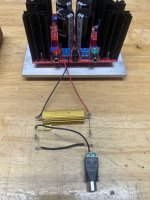
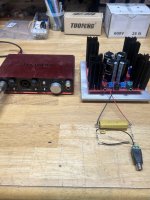
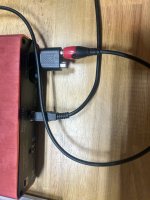
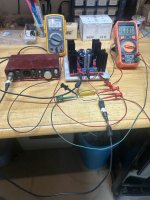
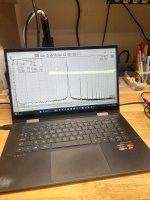
Photos attached show load resister + attenuator in their simplest form, followed by connections to sound card (Focusrite Scarlett 2i2) , connections to meters for monitoring voltages, and finally laptop with with REW spectrum analyzer and generator running. I'm thinking of doing a video on this set-up to help others give spectrum analysis a try...it's really quite fun and informative.





Last edited:
- Home
- Amplifiers
- Pass Labs
- DIY ACA mini